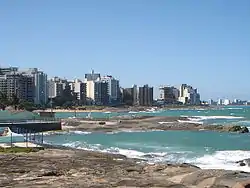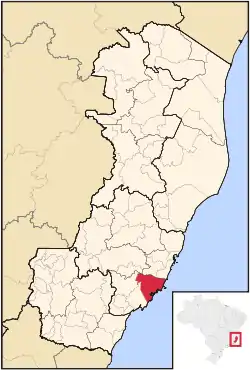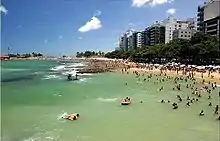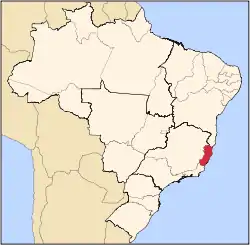Guarapari
Guarapari is a coastal town of Espírito Santo, Brazil, a popular tourist destination. Its beach is famous for the high natural radioactivity level of its sand.
Guarapari | |
|---|---|
Municipality | |
| The Municipality of Guarapari | |
 A view of Guarapari | |
 Flag .jpg.webp) Seal | |
| Nickname(s): "Barra" | |
 Location of Guarapari in the State of Espírito Santo | |
| Coordinates: 20°39′S 40°30′W | |
| Country | |
| Region | Southeast |
| State | |
| Founded | 1679 |
| Government | |
| • Mayor | Edson Magalhães (PSD) |
| Area | |
| • Total | 591,815 km2 (228,501 sq mi) |
| [1] | |
| Elevation | 15 m (49 ft) |
| Population (2020 est. [2]) | |
| • Total | 126,701 |
| • Density | 0.21/km2 (0.55/sq mi) |
| Time zone | UTC-3 (UTC-3) |
| HDI (2000) | 0.731 – high[3] |
Location
Guarapari is a part of Greater Vitoria, 47 km south of the state capital Vitória. Its population is 126,701 (2020) and its area is 592 km². It is a well-known tourist destination, known for its curving white sand beaches backed by commercial development, which extend southward to Nova Guarapari and Meaípe. With its heavily built-up coastline like Vila Velha and Vitória, it caters heavily to seasonal tourists, and consequently has quite a dramatic seasonal population fluctuation.
The municipality contains the 953 hectares (2,350 acres) Concha D'Ostra Sustainable Development Reserve, established in 2003 to protect the mangroves of the Bay of Guarapari.[4] It also contains the 1,500 hectares (3,700 acres) Paulo César Vinha State Park, which protects an area of dunes, lagoons and marshes along the Atlantic shore.[5] Formerly called the Setiba nature reserve, it is a pristine example of a coastal ecosystem and important for local turtle and bird populations.
History
The municipality has had European presence since 1585 when Jesuit missionaries built a small chapel and dug a well.
Transportation
The city is served by Guarapari Airport.
Radioactivity

Along a roughly 500-mile portion of Brazil's Atlantic coast that runs from north of Rio de Janeiro up to the region south of Bahia, the sands of old beaches are naturally radioactive. Sea waves pound coastal mountains rich in monazite, a phosphate of rare earth metals containing uranium and thorium.[6][7] The background radiation level on some spots on the Guarapari beach read 175 mSv per year (20μSv/h);[8] Some other spots reach 55 μSv/h,[9] while some even reach 131 μSv/hour (1148 mSv/year).[7] To place that in context, the average exposure level across the United States is ~0.34 μSv/hour[10] while a chest x-ray is a one time exposure of 0.1 mSv, and an abdominal and pelvic CT scan with and without contrast is 20-30 mSv.[11]
In the Guarapari city, radiation levels are far lower: a study among 320 inhabitants showed an average received dose of 0.6 µSv/h, corresponding to 5.2 mSv per year.[12]
References
- "Guarapari Código: 3202405". Cidades e Estados (in Portuguese). IBGE. Retrieved 2019-03-09.
- IBGE 2020
- "Índice de Desenvolvimento Humano - Municipal, 1991 e 2000" [Human Development Index - Municipal, 1991 and 2000] (in Portuguese). UNDP. Archived from the original on 2009-10-03.
- "RDS de Concha D'Ostra" (in Portuguese). IEMA: Instituto Estadual de Meio Ambiente e Recursos Hídricos. Archived from the original on 2016-10-28. Retrieved 2016-10-27.
- "Parque Estadual Paulo César Vinha" (in Portuguese). IEMA: Instituto Estadual de Meio Ambiente e Recursos Hídricos. Archived from the original on 2016-10-26. Retrieved 2016-10-26.
- "Heavy Minerals". Industrias Nucleares do Brasil. Archived from the original on 2012-11-27. Retrieved 2012-08-06.
- "High natural background radiation areas – Guarapari, Brazil". Japan: Health Research Foundation.
- Pfeiffer, W. C.; Penna-Franca, E.; Ribeiro, C. C.; Nogueira, A. R.; Londres, H.; Oliveira, A. E. (December 1981). "Measurements of environmental radiation exposure dose rates at selected sites in Brazil". Anais da Academia Brasileira de Ciências. 53 (4): 683–691. ISSN 0001-3765. PMID 7345962.
- "Brazil 2012: sunbathing on radioactive beaches" (Video). at 50s – via YouTube.
- "Relative Radioactivity Levels". Berkeley RadWatch. UC Berkeley. Retrieved 18 October 2018.
- "Radiation Sources and Doses". Radiation Protection. EPA.
- N. Fujinami; T. Koga; H. Morishima. "External Exposure Rates from Terrestrial Radiation at Guarapari and Meaipe in Brazil" (PDF). International Radiation Protection Association.
External links
 Guarapari travel guide from Wikivoyage
Guarapari travel guide from Wikivoyage- Guiacapixaba.net: Guarapari
- Webcitation.org: Guarapari Info—(in Portuguese)
- Guarapari.tiosam.org: Guarapari — history and travel tips—(in Portuguese)
- Agrogemeos.com: Google Map images of Guarapari
